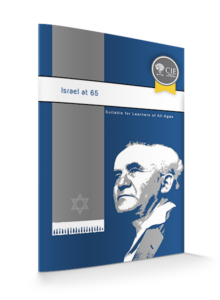Israel curriculum primarily focuses on Israel and not on Jewish studies or Jewish history. Of course, the context of modern Israel history or Israel studies evolves from the Jewish past. Here we are focusing on Zionism and Israel for formal and informal education settings. The following component elements are provided:
• Key curated essentials
• Self-learning, on-demand units
• Age-appropriate curriculum guides
• Teaching outlines and lesson plans
• Suggested terms, ideas and concepts
• Research bibliographies
• College syllabi
• Weekly Torah portion

The course syllabi were all used in college-level courses and are appropriate for advanced teen and adult education enrichment. The content and objectives of each course are reflected in the short introductory paragraph. Often the reading,…

Explore the connections between the self-reliance, resilience, and democratic local self-governance Jews developed and nurtured in the Diaspora and the institutions and systems that define the complex parliamentary democracy of the State of Israel and the role of nongovernmental organizations.
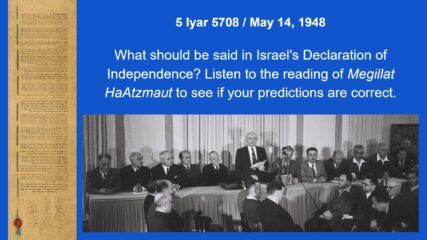
Pressman Academy in Los Angeles, part of CIE’s Day School Initiative, has graciously shared its Megillat HaAtzmaut and accompanying, grade-specific lesson plans for exploring Israel’s Declaration of Independence at Yom Ha’Atzmaut. Reading of Megillat HaAtzmaut:…

This video, prepared as Israel approached its 73rd birthday in 2021, incorporates multiple perspectives on the previous year. Have members of your class, in small groups or collectively, create a similar video addressing the highs…
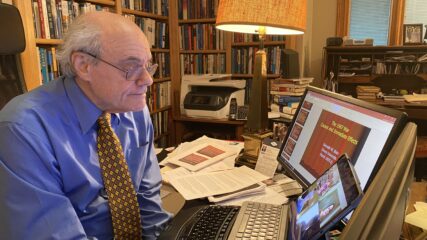
On January 1, 2022, I completed 43 years of teaching at Emory University. It was a great run and great fun. Along the way, I accumulated more pieces of paper than was necessary, among them…

CIE asked friends and experts in the field of Israel Studies to discuss the challenges and successes of the State of Israel in this past year, and to reflect on the coming year. Below, we…

Elections, Parliament, Political Culture, Prime Ministers, Parties and the Voting Public Israel has a parliamentary system of government with some unusual features in the elections and the creation of multiparty ruling coalitions, as explained by…
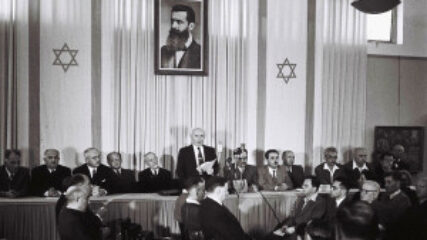
Israel’s Declaration of Independence is the source document of the Jewish state. Here we present a number of engaging learning activities for unpacking the document and helping learners interpret and make meaning for the past and present

Israel declared its independence on May 14, 1948. Every year since, we celebrate the rebirth of the modern Jewish state on the 5th of Iyar which was the date of independence on the Hebrew calendar. The resources provided here will assist you in bringing your community together to celebrate this joyous day.

Yom HaZikaron (Day of Remembrance) is Israel’s Memorial Day. In the early years of statehood, memorials for soldiers who had fallen in the 1948 War of Independence were held on Yom Ha’Atzmaut, Israel’s Independence Day. After Prime Minister David Ben-Gurion appointed a special committee, the memorials were moved to the 4th Iyar, the day before Yom Ha’Atzmaut. The day was anchored into Israeli law in 1963 with the passage of the Heroes’ Remembrance Day (War of Independence and Israel Defense Army) Law. This law was amended in 1980 to Memorial Day for the Fallen of Israel’s Wars Law.
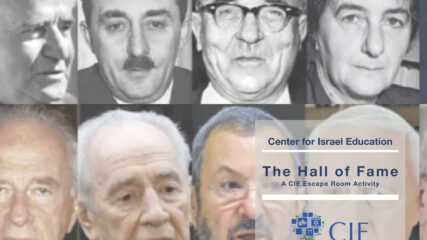
This escape room guides learners through a series of activities using a variety of original sources, ultimately directing them to learn about Shimon Peres, one of Israel’s longest serving and most influential leaders. While not all of the activities are directly related to Peres, they provide additional context into Israeli culture and society by exposing players to learn more about the country’s founding, its national anthem, and its food. The activity is designed for learners in grades 3-6.

“A Case Study in Nation Building: Israel” Dr. Nachman Shai, Emory University, Spring 2020 The nation-building experiment materialized in a variety of fields, including military defense, economy, agriculture, high tech and immigrant absorption, as well…

“Israeli Political Institutions: Formation and Dilemmas” Dr. Reda Mansour, Emory University, Spring 2018 This course explores the Israeli political system, its institutional characteristics and components, and its main political dilemmas. The course aims to provide…

“Israeli Diplomacy: History, and Politics” Dr. Reda Mansour, Emory University, Fall 2017 This course explores Israeli diplomacy from the state’s establishment in 1948 until now. We explore major changes in Israeli diplomacy through its many…

“History of Modern Israel” Kenneth W. Stein, Introductory Level (Seminar or General), Emory University, Spring 2016 This undergraduate lecture course focuses on the history, politics, society, economics and culture of modern Israel. It traces the…

“The Struggle for Israeli Identity” Nahum Karlinsky, Graduate Seminar, Ben-Gurion University, Spring 2016 We start by outlining the construction of Israel’s collective identity during the state’s formative years. We then discuss the shattering of that…

“Zionist and Israeli Political Leadership: Idealism, Realism and Pragmatism” Ziv Rubinovitz, Undergraduate, Emory University, Spring 2015 This course discusses the political leadership of the State of Israel as an introduction into Israel’s political system. The…

Netanyahu’s Speech at Bar-Ilan University, 2009 The two-state solution to the Israeli-Palestinian Conflict has many complex layers and unresolved variables that have prevented it from becoming a reality. The Political Significance of Land Purchase To…

Israeli Society and Politics” HIST 385 – junior/senior lecture Spring 2012 Semester – Yaron Ayalon View Syllabus The State of Israel was founded in 1948. For Jews, it was the fulfillment of a 2000-year long…

Balfour Declaration, 1917 The contents of the 1917 Balfour Declaration became central to the international recognition of the right of Jews to establish a national home/state. Building the State Before the State: Keren Hayesod Posters,…

Balfour Declaration, 1917 The contents of the 1917 Balfour Declaration became central to the international recognition of the right of Jews to establish a national home/state. Building the State Before the State: Keren Hayesod Posters,…

Kiryat Anavim, 1921 Immigrants to Israel in the 1920’s faced many difficulties and worked hard to build and develop the foundations for the Jewish State.
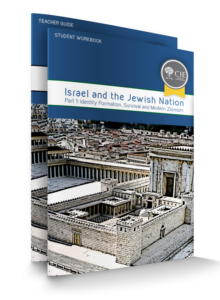
E-book
Covering the foundations of Judaism and the history of the Jewish people, the unit starts with the ‘covenants’ and ends in 1897. It traces the Jewish connection to the land of Israel, in the land and in exile. It explains how and why Jews retained their traditions in the face of enormous challenges. It concludes with the birth of Zionism as one answer to Jewish insecurity.
- Suitable for learners 9th grade and up
- The first of four planned units covering Israel and the Jewish Nation
- 37-page teacher guide
- 78-page student workbook
- Covers the foundations of Judaism and Jewish people starting with the ‘covenants’
- Learn how and why the Jews retained their traditions in the face of enormous challenges
- Explore the connection to the land of Israel and the birth of Zionism



